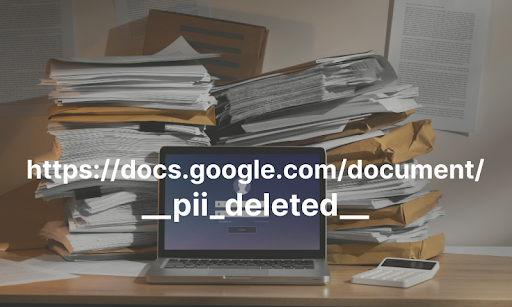Understanding Https://docs.google.com/document/__pii_deleted__: Comprehensive Guide to Protecting Your Privacy Online
In today’s digital landscape, safeguarding Personally Identifiable Information (PII) is more critical than ever. Google’s mechanism for PII removal ensures that sensitive personal data is not accessible through its search engine results. This article provides a thorough explanation of how Google’s PII removal works, the policies behind it, and the detailed evaluation process for removal requests. If you’re concerned about your private information appearing in search results, understanding this process is essential.
What Is PII and Why Does It Matter?
Personally Identifiable Information (PII) https://docs.google.com/document/__pii_deleted__ refers to any data that can directly or indirectly identify an individual. This includes full names, addresses, phone numbers, government-issued IDs, financial information, and more. The exposure of PII online can lead to identity theft, harassment, fraud, and other privacy violations.
Google, as the world’s leading search engine, indexes vast amounts of web data. Occasionally, sensitive PII might appear in search results due to public postings, data breaches, or malicious activities. To address these privacy concerns, Google has implemented a PII removal mechanism that allows individuals to request the removal of specific personal information from Google Search results.
Google’s PII Removal Policy: Protecting Privacy While Balancing Information Access
Google’s PII removal policy is designed to balance privacy rights and public interest. Not all personal information can be removed. For example, public records, professional contact information, and newsworthy content may remain indexed because they serve the public’s right to information.
Google’s policy primarily focuses on removing PII that poses a serious risk, such as:
- Social Security numbers or national identity card numbers
- Bank account or credit card numbers
- Images of signatures or personal documents
- Private medical records
- Personal contact details like home addresses or phone numbers when used maliciously
To enforce this, Google requires a formal request detailing the exact URL where the sensitive information appears, along with proof of identity of the requester to prevent fraudulent takedown demands.
Step-by-Step Guide to Submitting a PII Removal Request
Submitting a removal request for PII on Google involves several key steps:
1. Identify the Specific Content to Be Removed
First, locate the exact URLs where your PII is exposed. Google only removes information from its search index and does not remove content from the original website. Therefore, you must provide precise links.
2. Prepare Evidence and Identification
Google requires you to verify your identity to prevent abuse of the removal process. This usually involves submitting a government-issued ID or other verification means.
3. Fill Out Google’s PII Removal Form
Google provides a specialized form to report PII exposure. It asks for detailed information including:
- Your full name
- The specific PII involved
- URLs where the information appears
- Explanation of why the information is sensitive and needs removal
4. Submit the Request and Await Review
Once submitted, Google’s team reviews the request thoroughly. They evaluate the risk the exposed information poses, whether the information is publicly available elsewhere, and the overall impact on privacy.
How Google Evaluates PII Removal Requests
Google’s evaluation process is meticulous and prioritizes both privacy and public interest. Factors influencing their decision include:
- Type of information: Is the data sensitive PII like a social security number or financial detail?
- Source of content: Was the information posted by you, someone else, or a public database?
- Public interest considerations: Does the content serve a journalistic or legal purpose?
- Risk of harm: Could the exposure lead to identity theft, harassment, or other serious issues?
In cases where the information is part of public records or legitimate news stories, Google may deny removal requests. However, if the data is posted maliciously or exposes highly sensitive details, removal from search results is more likely.
Limitations of https://docs.google.com/document/__pii_deleted__ Process
It is crucial to understand what Google’s PII removal cannot do:
- Google does not delete content from the original websites. Removal only applies to Google Search results.
- If the data remains on the source website, it may still be accessible through other means.
- Removal is specific to Google Search and may not apply to other search engines.
- Google may refuse removal if the content is deemed of public interest or legally required to remain accessible.
Protecting Your Privacy Beyond Google: Additional Steps to Take
While Google’s PII removal mechanism is a valuable tool, protecting your privacy online requires a multi-layered approach:
1. Contact Website Owners Directly
If your PII is published on a website, request that the website owner or webmaster remove the content directly. This is often the most effective solution.
2. Monitor Your Digital Footprint
Use services or alerts to monitor where your personal information appears online. Early detection helps prevent wider exposure.
3. Use Privacy Settings on Social Media and Online Accounts
Regularly review and adjust privacy settings on social platforms to limit who can see your personal information.
4. Employ Professional Reputation Management Services
For serious cases involving data breaches or defamation, consider hiring experts specializing in online reputation and privacy protection.
Google’s Transparency and Commitment to Privacy
Google maintains a dedicated support page for PII removal requests, providing detailed instructions and examples. This transparency reflects their commitment to respecting user privacy while preserving the integrity of publicly available information.
They regularly update their policies to reflect legal changes, technological advances, and evolving privacy standards worldwide, ensuring their approach stays relevant and effective.
Frequently Asked Questions
What types of PII does Google remove from search results?
Google typically removes social security numbers, bank details, signatures, images of personal documents, and contact details when exposed maliciously or without consent.
How long does the PII removal process take?
The review process varies but usually takes a few days to several weeks, depending on the complexity of the request.
Can I request removal of my PII from all search engines?
No, Google’s removal process applies only to its search engine. You must contact other search providers separately.
What if Google denies my removal request?
You can review the reason for denial and take further steps, such as contacting the website owner or seeking legal advice.
Is the removal permanent?
Removal from Google Search results is not always permanent if the information reappears or the original content is republished.
Final Thoughts https://docs.google.com/document/__pii_deleted__
The Google PII removal mechanism offers a powerful means to protect your sensitive personal data from exposure in search results. By understanding the detailed policies, submitting accurate removal requests, and complementing this with proactive privacy management, individuals can better shield their personal information online.
Our commitment is to keep you informed and empowered with clear, actionable guidance to navigate Google’s PII removal process effectively, ensuring your privacy is respected in the digital age.
Keep an eye for more latest news & updates on Hamro Solarllc!






